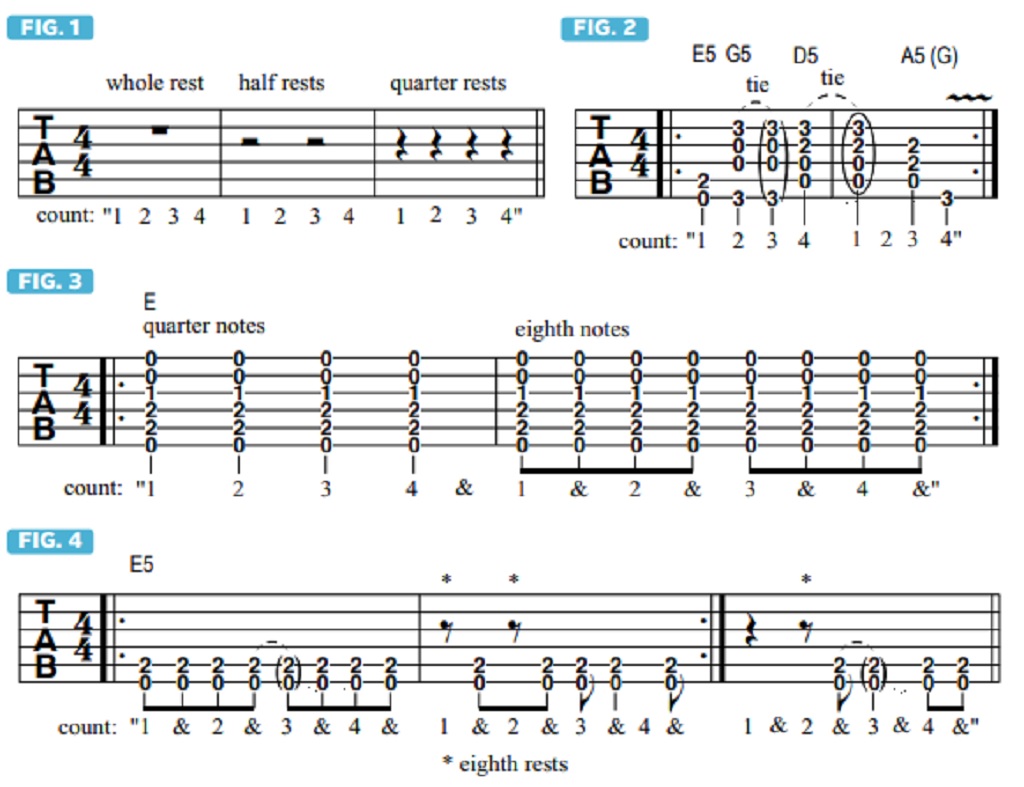Sharpen up your theory with this primer on eighth notes and rests
Get to grips with the most widely used rhythm in popular music
A rest is a hole of silence between any two notes or chords, and every rhythmic note value, such as a whole note, half note or quarter note, has a corresponding rest of equal duration, as indicated by the traditional symbols, or pictographs, shown in FIGURE 1, which are used in both Guitar World’s rhythmic tab notation and standard sheet music.
To remember these symbols, I’ve always found it helpful to think of a half rest as looking like a top hat and a whole rest like an upside-down top hat. And a quarter rest looks like a seagull in flight but with its wings rotated vertically.
A tie connects two neighboring notes or chords of the same pitch, resulting in a single note or chord that’s articulated only once and held for the combined duration of both rhythmic values. In standard sheet music, a tie is indicated by a curved line that arcs, like a rainbow, between two note heads that are on the same horizontal line or space on the five-line musical staff.
In rhythmic tab, fret numbers are used instead of note heads and are placed on a system of parallel horizontal lines that represent the guitar’s (or bass's) strings, with the lowest and thickest string being on the bottom.
There are so many cool things you can do with eighth notes to create interesting and exciting rhythms and phrases
A tie is indicated by a broken, or dashed, line that arcs from one tab number, or vertical stack of tab numbers, to an identical one that follows, which is enclosed in parentheses, unless it’s a half note or whole note, which already has a ring or an oval around it, making the parentheses too cumbersome to include (see FIGURE 2).
Getting back to basic note values, we learned in Part 1 that, in 4/4 meter, the quarter note serves as the foundational beat and counting unit - “1, 2, 3, 4, 1, 2, 3, 4,” etc. - and that a bar of 4/4 can include either one whole note, two half notes, four quarter notes or one half and two quarters.
Whole and half notes are considered multiples of the beat. We’re now going to explore subdivisions of the beat, which in 4/4 meter are any rhythmic values that are smaller and faster than a quarter note and thus shorter in duration.
If you take the four quarter notes that are in a bar of 4/4 and divide them equally in half, you then have eight eighth notes, which are twice as fast and are counted “1 and, 2 and, 3 and, 4 and, 1 and, 2 and, 3 and, 4 and,” etc., as shown in FIGURE 3, with the “and” counts being called the eighth-note upbeats.

Like a quarter note, an eighth note has, in standard notation, a vertical stem above or below a solid note head, or below a tab number in rhythmic tab. But it additionally has either a flag attached to the tip of the stem, if it’s a single eighth note, by itself, or, if it’s paired with another eighth note, a thick horizontal beam that connects the two vertical stems.
Getting back to the sound of eighth notes, this splitting, or doubling up, of the basic quarter-note pulse facilitates a much greater variety of rhythmic possibilities and range of musical expression, especially when combined with ties and eighth rests, as demonstrated in FIGURE 4.
Overall, eighth notes are the most widely used rhythm in popular music, especially in rock, metal, blues, jazz, country, bluegrass, folk and latin, as well as in classical music. And while there are many other, smaller rhythmic subdivisions of the beat, it is that eighth-note “1 and, 2 and, 3 and, 4 and, 1 and, 2 and, 3 and, 4 and” count and rhythmic undercurrent that is by far the most important rhythmic feel, or groove, that any aspiring musician and guitarist needs to master.
It is truly the heartbeat of popular music, and there are so many cool things you can do with eighth notes to create interesting and exciting rhythms and phrases, especially when you use them with various pitches and articulations, which is something we will continue exploring next time.
Get The Pick Newsletter
All the latest guitar news, interviews, lessons, reviews, deals and more, direct to your inbox!
Over the past 30 years, Jimmy Brown has built a reputation as one of the world's finest music educators, through his work as a transcriber and Senior Music Editor for Guitar World magazine and Lessons Editor for its sister publication, Guitar Player. In addition to these roles, Jimmy is also a busy working musician, performing regularly in the greater New York City area. Jimmy earned a Bachelor of Music degree in Jazz Studies and Performance and Music Management from William Paterson University in 1989. He is also an experienced private guitar teacher and an accomplished writer.











